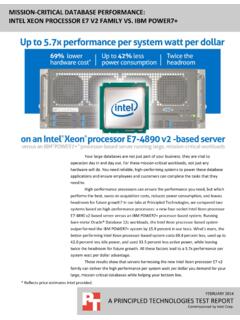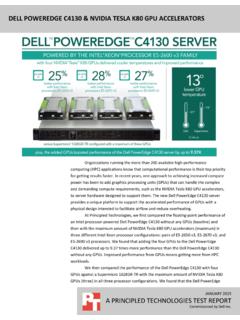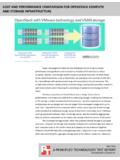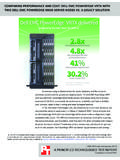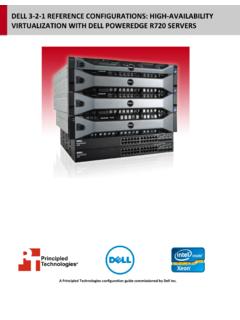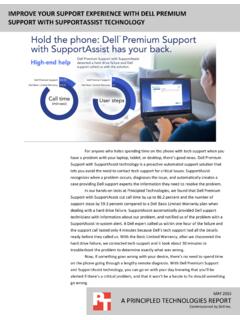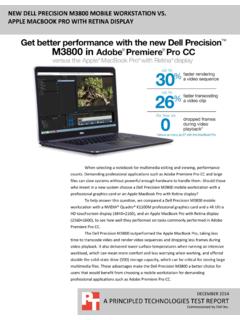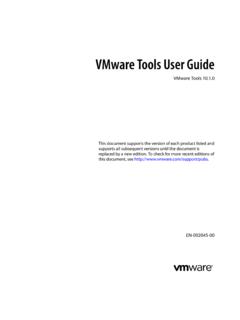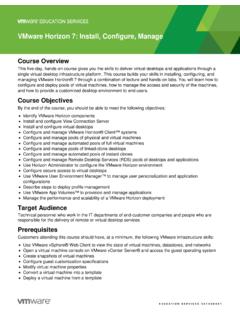Transcription of Dell PowerEdge VRTX and M-series compute nodes ...
1 DELL PowerEdge VRTX AND M-series compute nodes configuration study MAY 2013 A PRINCIPLED TECHNOLOGIES TEST REPORT Commissioned by Dell Inc. When deploying or upgrading IT infrastructure for existing office space or a new remote office, businesses face real challenges finding a solution that is easy to configure, provides the necessary hardware resources, is highly available, and mitigates unnecessary maintenance time and complexity. Taking hardware that happens to be around older servers that have been decommissioned, a storage array, and a few switches and cobbling it into a single solution may seem like a way of cutting acquisition costs, but can prove to be a false economy.
2 Any savings are offset by hours of effort and headaches to prepare, build, and maintain a legacy hardware solution, not to mention the ongoing risk of aged hardware. In contrast, the Dell PowerEdge VRTX solution, with up to four server nodes , shared networking, and storage, is very easy to configure and deploy. In our labs, we found that the Dell PowerEdge VRTX and four nodes , shared networking, and storage took less than 1 hour to unbox and configure into a highly available VMware vSphere cluster. Additionally, we found that it took percent less time and 150 fewer steps to configure and deploy out of the box compared to a similar infrastructure on four legacy tower servers, external network switches, and an external SAN.
3 Finally, deploying the Dell PowerEdge VRTX used just a single management tool compared to the six separate management tools the tower solution required. A Principled Technologies test report 2 Dell PowerEdge VRTX and M-series compute nodes configuration study WHY UPGRADE TO THE DELL PowerEdge VRTX? The drawbacks of a legacy hardware solution are many. Configuring this solution is time-consuming and may cause prolonged downtime during the setup phase. The aging hardware components may fail when you try to power them, you will likely have to reinstall operating systems from scratch, and compatibility issues often arise.
4 If the legacy hardware lacks built-in redundancy or high-availability features, a failed component can cause unexpected downtime. Last but not least, a group of mismatched components can look cluttered and could create cable management and logistical problems, and takes up more space than a streamlined solution. In addition to configuration drawbacks, repurposing older hardware can also mean having just enough hardware resources to meet current performance demands, with no planning room for future growth.
5 When your resource needs increase through the steady growth of your business or when workloads peak you will have to upgrade again. Deploying repurposed gear also forces you to rely on outdated hardware. While it is possible for a piecemeal solution to provide functions similar to those of newer server solutions, such as the Dell PowerEdge VRTX shared infrastructure, it may not provide comparable performance. The administrator who elects to compile a good-enough solution may have to accept reduced performance and frequent hardware service issues which may not be covered by warranties.
6 Finally, a solution consisting of disparate hardware components can be more difficult to manage remotely. For many businesses and remote offices that lack on-site IT administrators, this means that a hardware failure can require the IT admin to travel to the site to troubleshoot. This travel time extends downtime, costing your business money in lost productivity. The streamlined Dell PowerEdge VRTX solution can eliminate the drawbacks of repurposing older gear. You get the performance of Dell PowerEdge 12th generation M-series server nodes , shared networking, and shared storage in a space-efficient package that is easy to configure and manage.
7 To demonstrate the simplicity and speed of implementing this solution, we had a Dell PowerEdge VRTX shipped to our lab. Upon receipt, we determined the time, steps, and number of separate management tools necessary to configure the Dell PowerEdge VRTX into a four-node VMware vSphere cluster. We also set up a similar infrastructure using four different legacy tower servers, a network switch, and an external SAN. Figure 1 summarizes the differences between the two solutions. Dell PowerEdge VRTX solution Legacy hardware solution Time to set up 52 minutes 36 seconds 4 hours 5 minutes 8 seconds Number of steps 386 536 Number of management interfaces 1 6 Figure 1: Overview of the differences between the two solutions.
8 A Principled Technologies test report 3 Dell PowerEdge VRTX and M-series compute nodes configuration study Our test scenario simulates setting up a high-availability cluster at a remote site with functionality similar to what the Dell PowerEdge VRTX can provide. We compare this with a legacy hardware solution that used a variety of repurposed hardware to meet a similar goal. Implementing the legacy hardware approach required us to configure and troubleshoot each server using either its Web browser-based GUI or native physical console for the interface, set up and configure the managed switch using its dedicated browser-based management GUI, and configure the iSCSI shared storage system in yet another dedicated browser-based management GUI.
9 Each of these tools required separate credentials to manage. Appendix A provides detailed hardware configuration information. Appendix B provides detailed configuration information for the Dell PowerEdge VRTX solution we tested. Appendix C provides information on how we configured the traditional environment. QUICKER AND EASIER TO CONFIGURE As Figure 2 shows, configuring the Dell PowerEdge VRTX solution for use in a VMware vSphere High Availability (HA) cluster was quick, requiring only 52 minutes, 36 seconds of total setup time.
10 We completed all infrastructure configuration steps through the Dell Chassis Management Controller (CMC). The CMC is a Web-based management tool that provides a single graphical user interface for all of the components contained within the Dell PowerEdge VRTX chassis. In comparison, our traditional environment with mixed models and vendors required 4 hours, 5 minutes, 8 seconds to complete, without even considering the time it would take to locate and pull together all of the hardware necessary to implement a solution.

